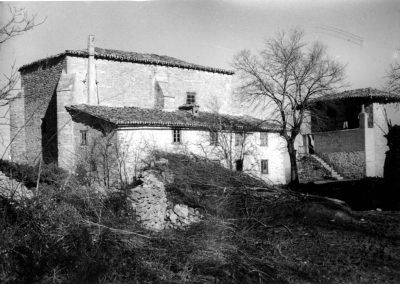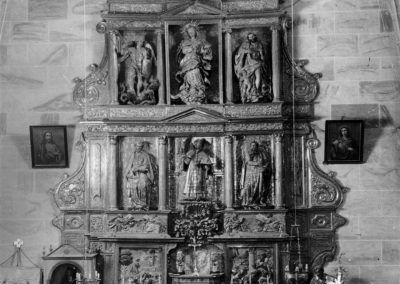
Una puerta digital abierta al patrimonio

Introduction
The first historical news that we have of Subijana de Álava dates from the early 11th century, when it was referred to as “Subillana”. Not far from there, also in Álava, there is another town known as Subijana-Morillas. This is why in recent times Subijana earned the nickname “de Álava” so that they could be distinguished. This enclave has suffered intense war periods over its history that have affected its heritage, which was despoiled during the first Carlist Wars. It was also one of the scenes of the well-known Battle of Vitoria, the last crash of the allies with the Napoleonic troops on their escape to France after losing the Peninsular War. This is the reason why in the vicinity there are still archaeological remains related to this war that took place on the 21st of June of 1813.
Palace of the Andas
One of the most interesting buildings of Subijana de Álava is, without the slightest doubt, the Palace of the Andas. The builder was Simón de Anda y Salazar, an important jurist and soldier, born in the town in 1709. Simón de Anda achieved to be governor of the Philippines and he also was in charge of the defence of this Spanish colony against the British when they occupied Manila in 1762. On his palace, a big coat of arms stands out, where the presence of an elephant gets our attention. This animal began to be part of the heraldry of Simón de Anda’s family as a result of the delivery of a pachyderm in 1773 from the distant Philippines to the court of Carlos III in Madrid. Simón de Anda was not buried in his hometown, but his grave is in the cathedral of Manila. Curiously enough, the English colonel Cadogan is buried in the palace instead. He died during the Battle of Vitoria and was buried by his compatriots in the garden, because it was the most luxurious building they found in the area.
If we compare the current appearance of the church of Saint Stephen with the photographs of the 20th century that have been preserved, we can see that the changes caused by the restorations have been scarce. On the separate bell gable we only see some minor modifications on the access to the bells and on the rest of the building the parish house and the additions of the 18th century are preserved. However, indoors, we can see that the church was repainted. This concealed the last mural paintings of the building, which were probably carried out in the 19th century or the early 20th century. As for the keystones, despite the black and white photographs, we could guess that there were coloured before the white paint covered the vaults completely.
Church of Saint Stephen
The constructive history of the church of Saint Stephen begins in the 16th century, when the walls and the current gate were built. It is crafted on a simple way, with an irregular cross of Saint James carved on the right side. The separate bell gable that we see on the outer square belongs to this same period, and also an architectural vestige on the north wall: a Late Gothic arch that could be the access to an old funeral chapel, now dismantled.
Inside the temple
Towards the interior, the nave was covered with ribbed vaults and intermediate ribs. These vaults are supported on corbels with Late Gothic decoration, based on leaves, branches, and plant-inspired motifs. In the area of the choir, the corbels show two male faces, which possibly belonged to an ecclesiastic and a nobleman, who seem to bear the weight of the ribs with their raised arms.
The set of keystones of the vaults connects with the usual theme of the early 16th century. In the area of the presbytery, the central keystone shows a blessing Christ, while the rest represent the Tetramorph or the four evangelists with their symbolic animal form. The arch that separates both vaults is crowned by an eight-pointed star, and on the section of the nave a single keystone shows us Saint Stephen, the advocation of the church.
The altarpiece
This saint dominates the main altarpiece, in which we also find other type of devotions, such as Saint Peter and Saint Paul. In the upper part, the Immaculate stands out, whom we see flanked by a Saint Michael killing the demon and weighing the souls, and a Saint Roch, who was invoked against the plague and protected from disease. We see a Calvary at the top, possibly older than the altarpiece, whereas at the bottom two reliefs stand out, which show us the scenes of the Agony in the Garden and the Flagellation of Christ.
Since the parish of Subijana de Álava did not have many economic resources at its disposal throughout time, this 17th-century altarpiece was purchased to the neighbouring town of Trespuentes in 1706. This caused the dismantling of the previous altarpiece and the reuse of some of its elements. Moreover, in order to update this piece to the new trends of the 18th century, a series of volutes were placed on both sides of the structure, with two Atlas that provide a rococo appearance.
The two side altarpieces date from this same century. The one on the left is dedicated to Our Lady of the Rosary, although we find a Saint Anthony on the upper area. On the one to the right, a Saint Joseph with the Child stands out of the central niche, a piece that due to its size was not designed for this altarpiece, which was originally dedicated to Saint Michael. At the top, there is a Saint Barbara, with the tower that characterises her, and a blessing God the Father crowns the ensemble.
The choir is raised at the feet of the church. Built in 1774 and very repainted in recent times, its front shows a big angel holding a scallop or shell. In this choir, an interesting baroque piece of furniture has been preserved: a continuous bench made of wood that keeps its original polychromy. The baptismal font is located on the area below the choir, smooth and without decorative motifs.
However, the highlight of the church of Saint Stephen of Subijana de Álava is inside the sacristy. The fact that the town had Simón de Anda among its neighbours explains the set of luxurious liturgical clothes that are kept in the closet. This complete trousseau from the late 18th century was brought from the distant Philippines and is embroidered in silk. Both the decorative motifs that are used and the material in which it is created show an unusual exoticism in our territory. As a curiosity, the cope was requested to be exhibited at the Seville Expo in 1992.
Créditos fotográficos:
De las fotografías actuales: © Alava Medieval / Erdi Aroko Araba
De las fotografías antiguas: Archivo del Territorio Histórico de Álava.

























